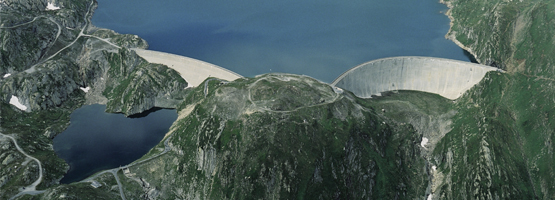Thanks to its topography and high levels of annual rainfall, Switzerland has ideal conditions for the utilisation of hydropower. Towards the end of the nineteenth century, hydropower underwent an initial period of expansion, and between 1945 and 1970 it experienced a genuine boom during which numerous new power plants were opened in the lowlands, together with large-scale storage plants.
Based on the estimated mean production level, hydropower still accounted for almost 90% of domestic electricity production at the beginning of the 1970s, but this figure fell to around 60% by 1985 following the commissioning of Switzerland's nuclear power plants, and is now around 57.6%. Hydropower therefore remains Switzerland's most important domestic source of renewable energy.
With the Energy Strategy 2050, the federal government aims to increase the average annual production of electricity from hydropower to 38,600 gigawatt hours (GWh) by 2050 (to 37,400 GWh by 2035). In order to use the realisable potential, existing plants should be renovated and expanded and the construction of new hydropower plants is needed, taking ecological requirements into account. The federal government wants to promote the utilisation of hydropower with various measures. The instruments for this are investment contributions for new plants and significant renovations/expansions of hydropower plants and the market premium for plants that have to sell on the market at prices below the production costs. In addition, thanks to the so called Mantelerlass, various measures are planned, which will improve the framework conditions for hydropower (simpler authorisation procedures, project planning contributions, target for storage expansion).
The Swiss Federal Office of Energy deals with policy-related aspects of hydropower (promotion, strategies, perspectives) as well as technical and safety aspects, while the Swiss Federal Office for the Environment is responsible for environmental aspects (residual water, protection of bodies of water).






